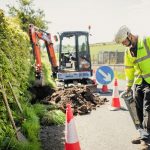Full Fibre’s Impact – Fibrus Report Makes Three Predictions for UK Rural Areas in 2025

Infracapital-backed alternative broadband ISP Fibrus, which is building a full fibre network across parts of Cumbria (England) and Northern Ireland, has published a new report that outlines three predictions for how the UK’s rural areas might look in 2050 and highlights the “extraordinary potential” of such communities as engines of growth.
The new ‘Future of Rural‘ report, which was commissioned by Fibrus and authored by “leading Applied Futurist“, Tom Cheesewright, looks ahead to 2050 and uses scenario planning and the latest data projections to explore how rural areas could “lead the way in economic, environmental, and social transformation“.
The report, which offers a fairly high-level view of the subject (i.e. limited details and statistics), indicates that with targeted investment, “particularly in connectivity and infrastructure“, the UK’s rural communities could help address some of the nation’s biggest challenges, from demographic change to climate resilience. It also outlines three predictions for how the UK’s rural areas might look in 2050:
Advertisement
Three Predictions for UK Rural Areas in 2025
The Remote Revolution:
While 2025 has seen reports of bosses demanding workers back to the office, the Future of Rural report has this as a temporary blip. By 2050, workers will have pushed for much greater flexibility to WFH. Advances in the metaverse digital infrastructure, AI and modern management techniques coupled with ubiquitous full fibre broadband will enable the shift back to remote working and a resurgence of rural lifestyles as the disadvantages of distance continue to diminish.
High Tech Harvest:
By 2050, the UK countryside could become ‘Silicon Valleys’, driven by a wave of new start-ups and clusters, spinning out of technology-focused agricultural educational institutions at the intersection of bio-science, robotics, energy and agriculture. Farming will become increasingly high-tech, with the use of human-scale androids, laser weeders and robot farm assistants piloted by smart glasses.
Destination UK:
As climate change alters global tourism patterns, the UK’s rural and coastal communities become sought-after destinations for visitors across Europe and America. AI powered translators and 3D avatar tour guides reshape tourist experiences, and artificial lakes and inland beaches give holidaymakers the quintessential beach holiday.
Naturally, all of this somewhat feeds into the vested interests of those deploying full fibre broadband and faster mobile technologies, such as Fibrus. So, take with the usual pinch of salt, as accurately predicting the future of such a long span of time is one of the hardest things to get right.
On the other hand, there’s little doubt that improving digital infrastructure in such areas does tend to deliver various economic and social benefits (here, here, here and here), while at the same time opening up lots of new opportunities for residents and businesses. But figuring out the reality of quite how much things will change is much harder.
Dominic Kearns, CEO and Co-Founder of Fibrus, said:
“At Fibrus, we set out to transform connectivity in rural areas, bringing them out of the digital dark ages and into a future of high-speed, reliable broadband. This report reinforces our commitment to those communities, highlighting their immense potential and the vital role they play in the UK’s growth.”
Too often, the UK’s urban areas and capital cities dominate when it comes to policy, pounds and progress, yet we have seen first-hand the level of entrepreneurship and agricultural best practice that is powering the nation from a grassroots level through improved digital access. We will not stop championing rural communities and driving progress until every home and business is truly connected”
Tom Cheesewright said:
“Many would be surprised at the extent to which the UK’s rural communities are already engines of growth. Even more would be surprised at their potential by 2050. With this report, we hope to inform and inspire, increasing the chance of these positive futures becoming reality.”
The provider’s Fibre-to-the-Premises (FTTP) broadband network has so far covered 440,000 UK premises and is home to 130,000 customers.
Mark is a professional technology writer, IT consultant and computer engineer from Dorset (England), he also founded ISPreview in 1999 and enjoys analysing the latest telecoms and broadband developments. Find me on X (Twitter), Mastodon, Facebook, BlueSky, Threads.net and Linkedin.
« Virgin Media UK Make Linear FAST TV Channel Content Available On-Demand
Advertisement
Leave a Reply Cancel reply
Privacy Notice: Please note that news comments are anonymous, which means that we do NOT require you to enter any real personal details to post a message and display names can be almost anything you like (provided they do not contain offensive language or impersonate a real person�s legal name). By clicking to submit a post you agree to storing your entries for comment content, display name, IP and email in our database, for as long as the post remains live.
Only the submitted name and comment will be displayed in public, while the rest will be kept private (we will never share this outside of ISPreview, regardless of whether the data is real or fake). This comment system uses submitted IP, email and website address data to spot abuse and spammers. All data is transferred via an encrypted (https secure) session.





















































I had a fibrus connection it was so unstable and despite many issues they never sent an engineer to my premises (only time I got one is when I flagged one down as they were working down the road opposite my house). I am now back on EE FTTC and the connection is a world apart from the Fibrus connection, with it being stable and reliable… Currently waiting on Openreach FTTP.
They’re forgetting one thing. The country’s skint, so it ain’t going to happen.
Many other Altnets would like to have the customer take up that Fibrus is achieving.